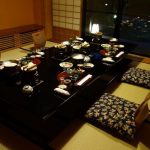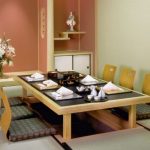Japanese Dining Table: A Unique and Elegant Dining Experience
When it comes to dining experiences, the Japanese are known for their attention to detail, precision, and elegance. This is reflected not only in their food but also in the way they present it on the dining table. One element that sets Japanese dining apart from other cultures is the traditional Japanese dining table.
Traditional Japanese dining tables are low tables that are close to the ground, typically around 15 to 30 centimeters in height. This design allows for diners to sit on tatami mats or cushions on the floor, known as zabuton, creating a cozy and intimate dining setting. This low-height table is called a chabudai, which translates to “low dining table” in Japanese.
The chabudai is typically made of wood and often has simple and elegant designs that reflect the minimalistic aesthetic of Japanese culture. These tables are usually square or rectangular in shape, but can also be round for a more casual dining experience. The low height of the table encourages diners to sit with good posture, promoting mindfulness and appreciation of the meal in front of them.
One of the key features of a traditional Japanese dining table is the absence of chairs. Instead, diners sit directly on the floor, kneeling or cross-legged, creating a more relaxed and informal atmosphere. This style of dining is not only comfortable but also promotes social interaction and closeness among diners.
In addition to the chabudai, a traditional Japanese dining table may also include other elements such as a shoji screen, a sliding door that separates the dining area from the rest of the house, or a hanging lantern to create a warm and inviting ambiance.
When it comes to dining on a Japanese dining table, there are certain etiquettes and customs that diners are expected to follow. For example, it is customary to remove your shoes before sitting down to eat, as it is considered disrespectful to bring outdoor dirt into the dining area. Additionally, diners are expected to use chopsticks to eat their meal and to show appreciation for the food by saying “itadakimasu” before starting and “gochisosama deshita” after finishing.
Overall, dining on a traditional Japanese dining table is a unique and elegant experience that allows diners to truly appreciate the art of Japanese cuisine. From the low-height table to the absence of chairs and the emphasis on mindfulness, every aspect of the dining experience is carefully thought out to create a memorable and enjoyable meal. So the next time you have the opportunity to dine on a Japanese dining table, be sure to savor every bite and moment of this special experience.
 lanzhome.com Interior and exterior design ideas
lanzhome.com Interior and exterior design ideas













